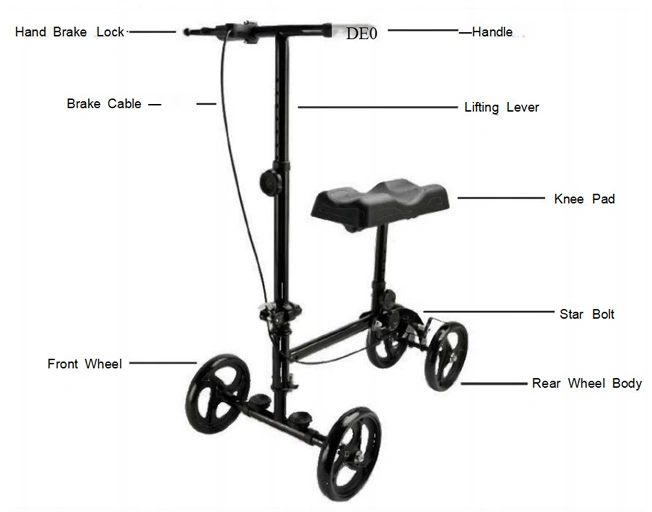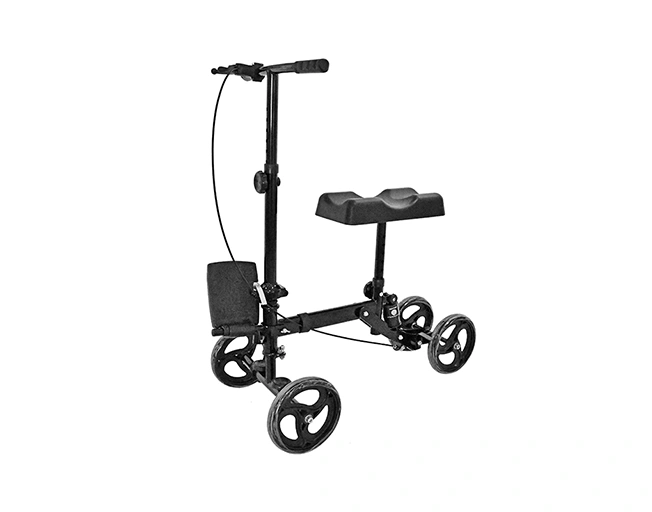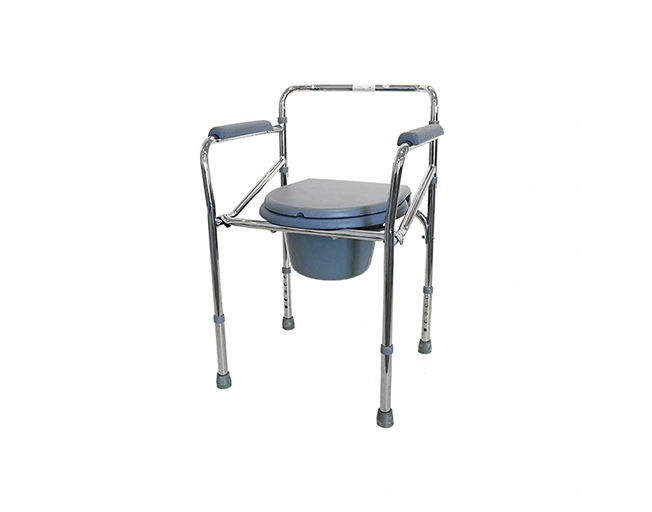How a Knee Rolling Walker Can Improve Mobility During Injury Recovery
Time : Oct 21, 2025 View : 1,350
Getting better from a leg injury, like a broken foot or a torn Achilles tendon, takes more than just sitting still. You need tools to stay active and independent. Knee rolling walkers, sometimes called knee scooters, are devices with four wheels. They’re a smart pick over crutches. You rest your hurt leg on a soft pad and push with your good leg. This setup gives you steady balance. It eases strain on your arms and shoulders. It also helps you move around better. These walkers are great for long recoveries. They keep you comfortable and safe. You can do daily tasks with less pain. They also cut the chance of hurting yourself more.

What Is a Knee Rolling Walker?
A knee rolling walker is a tool to help you move. It supports your injured leg while you use the other to get around. It’s a solid, comfy choice for people healing from leg injuries.
Design and Structure
The walker has a cushioned spot for your hurt leg. It comes with handlebars you can tweak for steering. Hand brakes keep you safe by stopping fast. The wheels work inside or outside. The size of the wheels matters. Tiny wheels are good for home. Bigger ones tackle rough spots like sidewalks. To keep it clean, wipe it with a wet cloth now and then. This keeps it safe to use and makes it last.
Comparison with Other Mobility Devices
Crutches and regular walkers need strong arms. Knee walkers don’t. They let your healthy leg do the work. This means less tiredness. Moving feels safer and easier. For lots of recoveries, knee walkers are a better pick than other aids.
Types of Knee Walkers
There are different kinds to fit what you need:
-
Basic Indoor Scooters: Small and great for moving around the house.
-
All-Terrain Models: Have larger wheels. They work on bumpy outdoor ground.
-
Foldable Ones: Light and easy to carry. Many have baskets to hold stuff when you’re out.
Benefits of Using a Knee Rolling Walker
Knee walkers make healing easier. They keep you safe and make everyday life better.
Better Balance and Steadiness
With four wheels touching the floor, these walkers are super stable. The handlebars feel nice in your hands. Steering is a breeze. You can slip through tight spots, like small hallways, without worry. Unlike crutches, they make falling or tripping way less likely.
Less Strain on Your Upper Body
Crutches wear out your arms and shoulders. That leads to aches. Knee walkers let you steer with little effort. Your arms and shoulders don’t get sore. This is awesome for avoiding joint pain. It’s especially good for older folks or anyone with weaker arms.
Comfy for Long Use
The knee pad is soft, with stuff like foam or gel. It holds your leg gently. You won’t get bruises or feel uncomfortable. You can use it for hours without hurting. This is huge for long recoveries. It works at home or when you’re out doing chores.
More Freedom
Knee walkers slide easily over different surfaces. You can cook, shop, or go to appointments by yourself. Some have baskets or pouches for carrying things like books or snacks. This makes life simpler than using crutches or a wheelchair.
Choosing the Right Knee Rolling Walker
Picking the best one depends on what you need and where you’ll use it. This makes sure it works perfectly for you.
Things to Think About
Make sure the walker can hold your weight. Look for handlebars and knee pads you can adjust. This helps you stand up straight. It stops back pain. Think about where you’ll use it most. Small wheels are fine for inside. Bigger wheels are better for outdoor places like parks. If you travel a lot, a foldable one is easy to pack and store.
Features That Make It Better
Get one with a thick, soft knee pad. It keeps your leg happy during long use. Hand brakes are a must for staying safe, especially on hills or rough ground. Some have double brakes for extra control. A strong frame is important. It should feel tough but not too heavy to push. Extras like bags or cup holders help with tasks. You can carry water or groceries easily.
How to Use It Right
Using the walker the right way keeps you safe. It helps you heal faster. It also lowers the chance of new injuries.
Getting On and Off
Lock the brakes before you get on. Set your injured leg gently on the pad. Hold the handlebars to stay balanced. This keeps you steady and stops wobbling.
Moving Around
Be careful turning corners. Go slow when you switch surfaces, like from carpet to tile. Outside, stick to smooth ground. Skip bumps or obstacles to stay safe.
Taking Care of It
Check the walker often. Look for loose or worn-out parts. Fix them before using it. Keep it in a cool, dry spot to avoid rust. Regular care makes it last longer.

Injuries It’s Good For
Knee walkers are perfect when you can’t put weight on your leg. They let you move without slowing your healing. They work for:
-
Foot Fractures and Surgery Recovery: Great for things like bunion surgery or broken foot bones. They keep weight off your foot.
-
Achilles Tendon Injuries: They take pressure off your ankle. You can move safely while healing.
-
Bad Ankle Sprains: They support your ankle. You stay active without risking more injury.
Limits
Knee walkers don’t work for injuries to both legs. They’re also not great if your arms are too weak. A wheelchair is better in those cases. Talk to a doctor to see if a knee walker is right for you.
Comparing Knee Walkers to Other Aids
Knowing how knee walkers stack up helps you choose the best one.
Knee Walkers vs. Crutches
Knee walkers are comfier and steadier. They’re easier for long use. But they can be bulky in small spaces. Crutches are easier to carry but make you tired. They also hurt your joints over time.
When to Pick a Wheelchair
Wheelchairs are better if both legs are hurt. They’re also good if your arms can’t steer a knee walker. Wheelchairs take less effort to use.
Canes and Regular Walkers
Canes don’t give much support. They’re not good for injuries where you can’t put weight on your leg. Regular walkers are steady but slow. They’re not as comfy as knee walkers. This makes them less great for many recoveries.
Living with a Knee Walker
Changing your routine can make recovery easier with a knee walker.
Handling Tough Spots
Stay away from stairs unless someone helps. Use ramps when you can. On slopes, press the brakes lightly. This avoids sudden stops and keeps you safe.
Doing Daily Stuff
Wear loose clothes to move freely. Set up your kitchen or desk so things are close. This cuts down on strain while you stay busy.
Avoiding Tiredness
Take breaks if you use it a lot. This keeps your good leg from getting worn out. Plan your day to stay comfy and avoid aches.
Xunyu Medical: A Trustworthy Supplier
Xunyu Medical is in Foshan City, Guangdong. They make tools for injury recovery and elderly care. Their knee rolling walkers are built for comfort and real-world use. They’re great for home or rehab centers.
What They Offer
-
Bedside Handrails: Strong and simple to set up for medical needs.
-
Crutches: Light and adjustable to help you move.
-
Wheelchair: Made for safety and comfort.
-
Bath Chair: Has non-slip seats and holes for safe bathing.
-
Walking Aids: Designed for older folks to use easily.

Focus on Quality
Xunyu Medical works from a 4,000-square-meter building. They focus on new ideas and tough quality tests. Their products meet world standards. This keeps users safe and happy.
Conclusion
Knee rolling walkers make recovering from leg injuries so much better. They give you steady support, comfort, and freedom. Compared to crutches or wheelchairs, they’re easier on your arms. You can move confidently on different surfaces. Picking the right one means checking your weight, adjustability, and where you’ll use it. This leads to a smoother recovery. Always talk to a doctor to make sure it fits your injury. Companies like Xunyu Medical make top-notch walkers. They help you heal with ease and stay independent.
FAQs
Q1: What injuries work best with a knee rolling walker?
A: They’re great for injuries where you can’t put weight on your leg. Think broken feet, torn Achilles tendons, bad ankle sprains, or after-surgery recovery. They let you move without hurting the healing spot.
Q2: Can I use a knee walker outside?
A: Yup! Models with bigger wheels are made for outdoors. Pick an all-terrain one for rough ground. It keeps you steady and moving smoothly.
Q3: How do I make sure it fits right?
A: Choose one with adjustable handlebars and knee pads. Check that it holds your weight. A good fit keeps your posture right and stops muscle aches.


